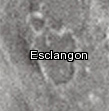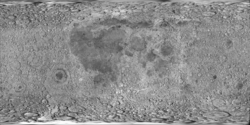Esclangon (kráter)
| Kráter Esclangon | |
|---|---|
 | |
| Souřadnice na Měsíci | |
| Selenografická šířka | 21,5° S |
| Selenografická délka | 42,1° V |
| Další údaje | |
| Průměr kráteru | 16 km [1] |
| Hloubka | 0,4 km |
| Colongitudo | 318° |
| Eponym | Ernest Esclangon |

Esclangon je lunární kráter nacházející se v pevninském terénu východně od Sinus Amoris (Záliv lásky) na přivrácené straně Měsíce. Má průměr 16 km, pojmenován je podle francouzského astronoma Ernesta Esclangona.[1][2] Jedná se o lávou zatopený kráter s nízkým okrajovým valem. Má nepravidelný tvar, v severozápadní a severovýchodní části je val vyboulen, pravděpodobně se zde nacházely menší krátery, které se po zatopení sloučily s hlavním Esclangonem. Než jej Mezinárodní astronomická unie v roce 1976 přejmenovala, nesl název Macrobius L.[1]
Východně leží komplexní kráter Macrobius, jihozápadně se nachází kráter Hill. Severovýchodně se rozprostírá Lacus Bonitatis neboli Jezero štědrosti.[1]
Odkazy
Reference
Literatura
- RÜKL, Antonín. Atlas Měsíce. 2. vyd. Praha: Aventinum, 2012. ISBN 978-80-7151-269-1.
Externí odkazy
 Obrázky, zvuky či videa k tématu Esclangon na Wikimedia Commons
Obrázky, zvuky či videa k tématu Esclangon na Wikimedia Commons - Kráter Esclangon Archivováno 29. 3. 2018 na Wayback Machine., Moon-Wikispaces.com (anglicky)
- LAC 43, mapa 1:1 000 000 (Lambertova projekce)
Média použitá na této stránce
cylindrical map projection of the Moon. The Moon's whole surface was mapped by the Clementine spacecraft in 1994, here North is at the top. The dark floor of crater Plato is at the middle top above Mare Imbrium, while the bright floor and rays of crater Tycho is near the middle bottom below Mare Imbrium. Mare Procellarum is at the near left, and Mare Tranquillitatis is just right of centre and Mare Crisium is at the near right. The far left and far right show the contrast of the mostly cratered farside with small isolated mare.
Esclangon lunar crater as seen from Earth with satellite craters labeled
Sinus Amoris and Lacus Bonitatis with craters Roemer, Macrobius, Maraldi and others (detail of LROC - WAC global moon mosaic)



